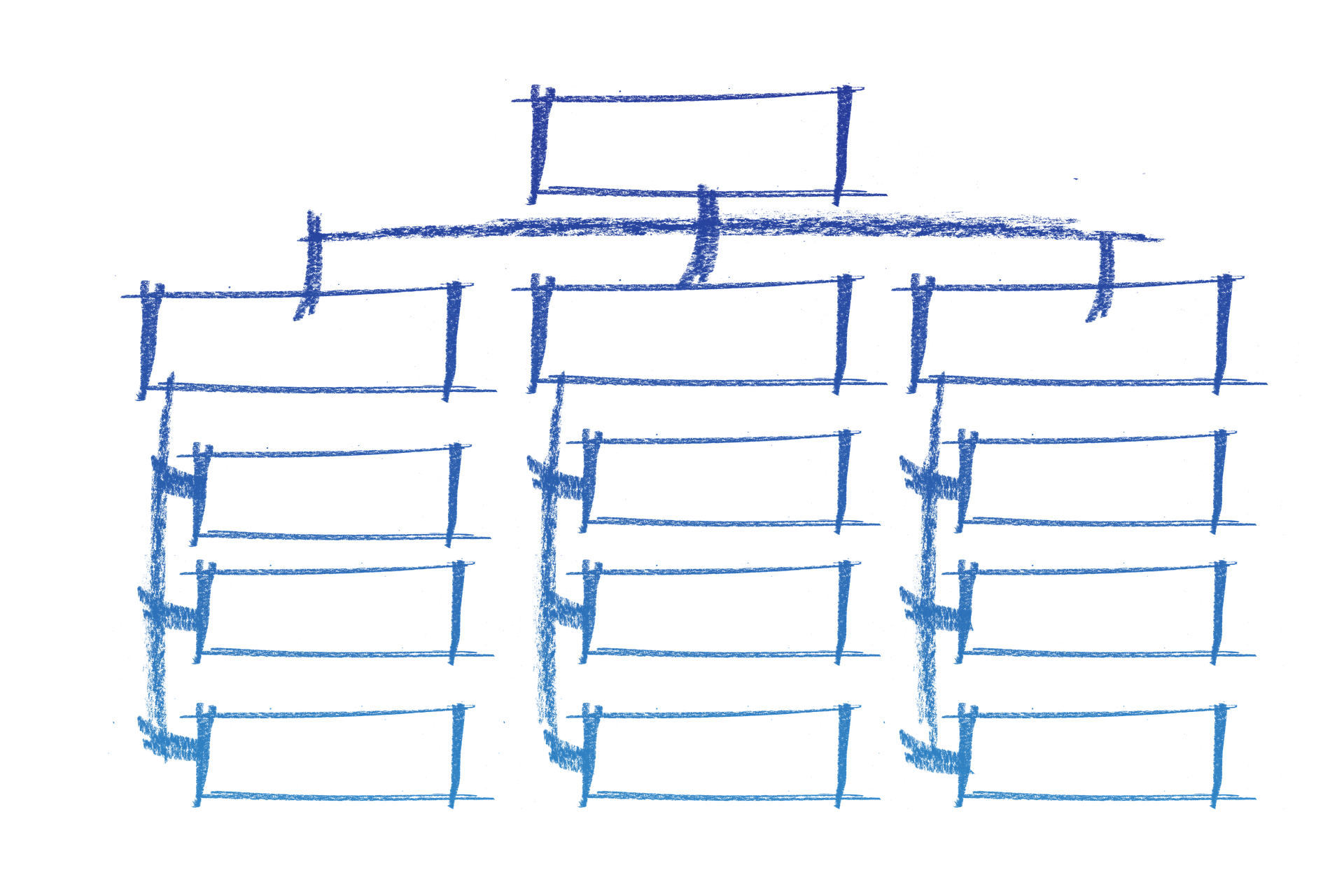14.5: What is Organizational Structure?
- Page ID
- 48769
Learning Objectives
- Discuss the elements of organizational structure
 A worker reports to a manager. A manager reports to a director, a director reports to a vice president, and a vice president reports to a C-level senior leader, like a chief executive officer or a chief administrative officer. If you’ve ever worked in a corporate setting, you’re likely to recognize this as the basic set of layers of an organization’s structure.
A worker reports to a manager. A manager reports to a director, a director reports to a vice president, and a vice president reports to a C-level senior leader, like a chief executive officer or a chief administrative officer. If you’ve ever worked in a corporate setting, you’re likely to recognize this as the basic set of layers of an organization’s structure.
Organizational structure defines how job tasks are formally divided, grouped, and coordinated. The structure of an organization usually features six different elements:
- Work specialization
- Departmentalization
- Chain of command
- Span of control
- Centralization and decentralization
- Formalization
Practice Question
Now that we understand just what organizational structure is, let’s take a look at each one of its elements, so we can better understand how organizations choose to structure themselves to maximize productivity.
Work Specialization
Earlier, we studied Frederick Winslow Taylor, who researched time and motion and determined the most efficient ways for workers to do their tasks. Taylor’s “one right way” was the birth of work specialization. When Henry Ford conceived the assembly line, he tossed aside “one best way” and viewed work specialization with an eye toward continued improvement. Work specialization describes the degree to which activities in the organization are divided, and then subdivided, into separate jobs.
If you put one worker on the task of building an automobile, he might still be building it a month or two later. But if you have one worker that’s focused on installing right front tires, and another who is focused on left front fenders, then those tasks become standardized. Employees learn to do them quickly with practice.
By the 1940s, most manufacturers were practicing work specialization, or “division of labor” as it’s sometimes called. Work specialization was ideal from a task point of view—easy tasks could be done by unskilled labor, and those tasks that required more skill could be separated out and addressed by employees that possessed those skills. Those skilled employees weren’t wasting their time on tasks they didn’t have to be doing.
Work specialization was also ideal from a productivity point of view. Installation of brake pads requires different tools than the installation of a tire, and when workers were assigned to one of those tasks instead of both, tools didn’t need to be taken out and put away. Employees could cheaply be trained to do one specific task, and many employees, each trained to do their specific task, could assemble highly complex machinery quicker and easier than one highly trained employee that possessed all the skills to complete the assembly.
Manufacturers continued to tinker with and fine-tune worker specialization to increase productivity until the 1960s, when it became clear that a good thing could be taken too far. Boredom, stress, low productivity, increased absenteeism and turnover offset higher productivity. Manufacturers responded by enlarging worker specialization, including more tasks within a position to increase engagement.
Departmentalization
Once jobs are divided up through work specialization, those jobs need to be combined together to coordinate common tasks. Departmentalization is the basis by which jobs are grouped together. Jobs can be grouped in the following ways.
- Function. This is among the most popular way to group activities. Corporations might have a supply chain function, a finance function, a human resources function. All the worker specializations for those areas are grouped together, and people with common skills work in common units.
- Product. A large manufacturing company might group its common tasks together by product. A paper products manufacturer might have a department for office paper, and other department for bathroom tissues, and yet another for cartons. The major advantage of organizing common tasks this way is to increase employee accountability for the success of those products.
- Geography. If an organization’s customers are scattered over a geographic region, an organization might choose to group common tasks geographically. A company that has a South, Midwest, and Eastern sales function is organizing around territory, or geography.
- Process. A manufacturing plant might choose to organize common tasks around process. A tubing plant might organize departments around casting, pressing, finishing, packaging, etc. Each department specializes in one particular part of the manufacturing process. The same kind of departmentalization is true of the Department of Motor Vehicles, where you proceed from one area to another to renew your license plates or your driver’s license.
- Customer. A business might choose to combine tasks around the type of customer it serves. For instance, a service like Dropbox.com has free file sharing and cloud storage for its individual users, but there is also a department of Dropbox that services business clients.
Large corporations can use any or all of these types of departmentalization to organize themselves. They might have a manufacturing area that organizes itself around process, but then a sales department that is organized geographically and a corporate support center that’s organized functionally.
Chain of Command
 The chain of command is the unbroken line of authority that extends from the top of the organization (e.g., the CEO or the President) to the lowest echelon and clarifies who reports to whom. At the beginning we talked about managers reporting to directors, who reported to vice presidents who reported to C-level leaders. Such is the chain of command.
The chain of command is the unbroken line of authority that extends from the top of the organization (e.g., the CEO or the President) to the lowest echelon and clarifies who reports to whom. At the beginning we talked about managers reporting to directors, who reported to vice presidents who reported to C-level leaders. Such is the chain of command.
Two additional concepts go along with the idea of chain of command. The first, authority, describes the rights inherent in a managerial position to give orders and to expect the orders to be obeyed. The second, unity of command, describes the concept that a subordinate should only have one superior to whom he or she is directly responsible. If unity of command doesn’t exist, there’s a likelihood that a subordinate will be responding to commands from different people and experiencing a dilemma of competing priorities, which isn’t productive.
We learned about Henri Fayol and his theories around management, particularly chain of command and unity of command. These principles used to be a cornerstone of organizational structure, but advancements in technology and the trend toward empowering employees makes this less relevant today, but the chain of command element is not going to disappear any time soon.
Span of Control
Span of control deals with the number of subordinates a manager can effectively direct. The wider an organization can make its managers’ spans of control the more efficient it will be. Wider spans of control save money.

Consider the span of control of the company represented in the drawing above in blue. The blue company has 5,461 employees and six levels of managers to manage them (all but the bottom layer of 4,096). Let’s say those managers make $50,000 apiece. The total payroll for 1,365 managers making $50,000 apiece is $68,250,000.
If we look at the green company, we still have a bottom layer of 4,096, but less managers overall managing them. If the green company’s 585 managers each make $50,000, the green company’s total payroll for those managers is $29,250,000. That’s a huge savings.
Small spans of control are not only expensive, but they tend to complicate communication up and down the organization. The more layers, the more the message has to travel from manager to manager. Narrower spans of control also encourage overly tight supervision and less employee creativity and empowerment. In recent years, the trend has been toward wider spans of control.
Centralization and Decentralization
Centralization refers to the degree to which decision making is concentrated at a single point in the organization.
In a decentralized organization, employees are empowered to make decisions, so action can be taken quickly to solve problems, and employee input is considered. The more lower-level employees have the power to make decisions, the more decentralized an organization is.
In a centralized organization, upper management makes all decisions and lower management is there to carry those decisions out.
Formalization
Formalization refers to the degree to which jobs within the organization are standardized. An employee in a highly formalized job has little input as to how that job is done, when it’s done or how it should be done.
A worker on the assembly line is probably in a highly formalized job, where he doesn’t have much say in how he does his job. An accounts payable associate also doesn’t have a lot of say in how those many invoices are processed, but her job is probably a little less formalized than the assembly line worker. A sales associate, out calling on customers, may have very little formalization in his job.
Practice Question
Now that we understand the six elements that figure into organizational structure, let’s take a look at some common configurations of organizational structure and in what instances they are used.
Contributors and Attributions
- What is Organizational Structure?. Authored by: Freedom Learning Group. Provided by: Lumen Learning. License: CC BY: Attribution
- Image: Span of Control. Provided by: Lumen Learning. License: CC BY: Attribution
- Organization Chart. Authored by: Gerd Altmann. Provided by: Pixabay. Located at: pixabay.com/illustrations/organization-chart-1989132/. License: CC0: No Rights Reserved. License Terms: Pixabay License
- Chain. Authored by: Peggy and Marco Lachmann-Anke. Provided by: Pixabay. Located at: pixabay.com/illustrations/chain-strong-protection-1027864/. License: CC0: No Rights Reserved. License Terms: Pixabay License

